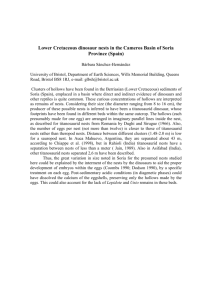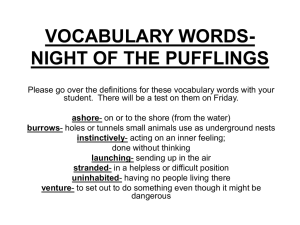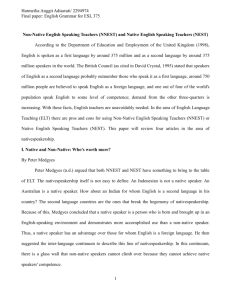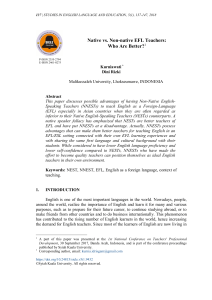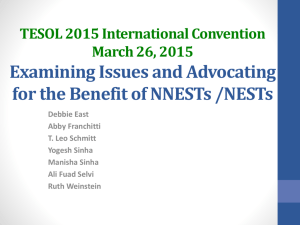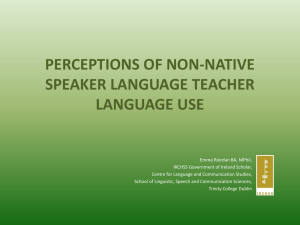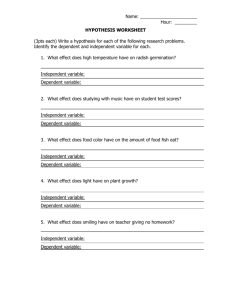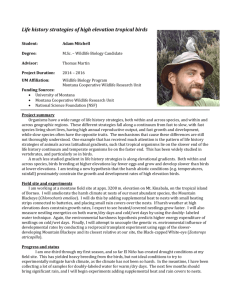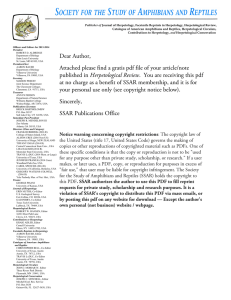Native and Non-Native English
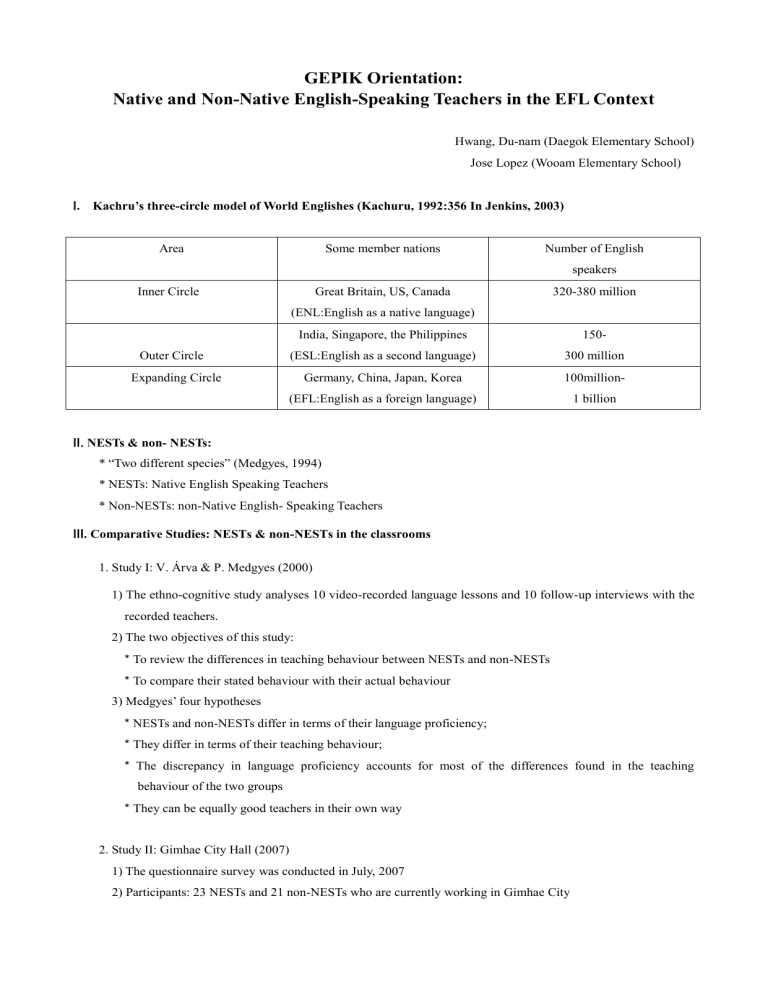
GEPIK Orientation:
Native and Non-Native English-Speaking Teachers in the EFL Context
Hwang, Du-nam (Daegok Elementary School)
Jose Lopez (Wooam Elementary School)
І
. Kachru’s three-circle model of World Englishes (Kachuru, 1992:356 In Jenkins, 2003)
Area Some member nations Number of English speakers
320-380 million Inner Circle
Outer Circle
Expanding Circle
Great Britain, US, Canada
(ENL:English as a native language)
India, Singapore, the Philippines
(ESL:English as a second language)
Germany, China, Japan, Korea
(EFL:English as a foreign language)
ІІ.
NESTs & non- NESTs:
* “Two different species” (Medgyes, 1994)
* NESTs: Native English Speaking Teachers
* Non-NESTs: non-Native English- Speaking Teachers
150-
300 million
100million-
1 billion
Ⅲ
. Comparative Studies: NESTs & non-NESTs in the classrooms
1. Study І: V. Árva & P. Medgyes (2000)
1) The ethno-cognitive study analyses 10 video-recorded language lessons and 10 follow-up interviews with the recorded teachers.
2) The two objectives of this study:
*
To review the differences in teaching behaviour between NESTs and non-NESTs
*
To compare their stated behaviour with their actual behaviour
3) Medgyes’ four hypotheses
*
NESTs and non-NESTs differ in terms of their language proficiency;
*
They differ in terms of their teaching behaviour;
*
The discrepancy in language proficiency accounts for most of the differences found in the teaching behaviour of the two groups
*
They can be equally good teachers in their own way
2. Study ІІ: Gimhae City Hall (2007)
1) The questionnaire survey was conducted in July, 2007
2) Participants: 23 NESTs and 21 non-NESTs who are currently working in Gimhae City
3) The three focuses of this study
* To compare the two groups’ perceptions of their teaching behaviour
* To review the constraints and strategies the two groups involved
* To look for more efficient ways of co-teaching
3. P e r c e i v e d d i f f e r e n c e s i n t e a c h i n g b e h a v i o u r b e t w e e n N E S T s a n d n o n - N E S T s
(V. Árva & P. Medgyes in 2000)
1) Own use of English
NESTs Non-NESTs
Speak better English
Use real language
Use English more confidently
Speak poorer English
Use ‘bookish’ language
Use English less confidently
2) General attitude
NESTs
•
Adopt a more flexible approach
•
Are more innovative
•
Are less empathetic
•
Attend to perceived needs
•
Have far-fetched expectations
•
Are more casual
•
Are less committed
Non-NESTs
•
Adopt more guided approach
•
Are more cautious
•
Are more empathetic
•
Attend to real needs
•
Have realistic expectations
•
Are more strict
•
Are more committed
3) Attitude to teaching the language
NESTs Non-NESTs
•
Are less insightful
•
Focus on fluency, meaning, language in use, oral skills, colloquial registers
•
Teach items in context
•
Prefer free activities
•
Favor group work / pair work
•
Use a variety of materials
•
Tolerate errors
•
Set fewer tests
•
Use no/less L1
•
Resort to no/less translation
•
Assign more homework
•
Are more insightful
•
Focus on accuracy, form, grammar rules, printed word, formal registers
•
Teach items in isolation
•
Prefer controlled activities
•
Favor frontal work
•
Use a single textbook
•
Correct/penalize for errors
•
Set more tests
•
Use more L1
•
Resort to more translation
•
Assign more homework
4) Attitude to teaching culture
NESTs
Supply more cultural information
Ⅳ.
Suggestion
Non-NESTs
Supply less cultural information
Teacher education including thorough in-service training for both NEST and non-NEST group will play a crucial role for Native/non-native collaboration in making teachers aware of their assets and in preparing them to exploit these assets in the development of an appropriate pedagogy.
1.
Linguistic competence + Professional expertise
“There has often been the danger of an automatic extrapolation from competent speaker to competent teacher based on linguistic grounds alone, without taking into consideration the criteria of cultural, social, and pedagogic appropriacy.” (Seidlhofer, 1996. In Árva, V. & Medgyes, P.,
2000)
2.
Non-native assets
“ Non-native EFL teachers are double agents. They are at home with the language(s) and culture(s) they share with their students, but they also know the relevant terrain inhabited by the target language… this makes non-NESTs uniquely suited to be agents facilitating learning by mediating between the different languages and cultures through appropriate pedagogy.”
( Seidlhofer, 1999, p.235)
3. Native Assets
“In addition to serving as ‘perfect language models’ NESTs were rich sources of cultural information…about any topic around which the lessons were structured.”
“The four NESTs proved to be good facilitators…They were well-trained debaters…But above all,
NEST were good listeners who showed genuine interest in whatever the students had to say.”
(V. Árva & P. Medgyes, 2000, P.365 )
REFERENCES
1. Árva, V. & Medgyes, P., 2000. Native and non-native teachers in the classroom. System 28, 355-372.
2. Jenkins, J. 2003. World Englishes . London: Routledge.
3. Medgyes, P., 1994. The non-native teachers. Macmillan Publishers, London.
4. Seidlhofer, B.,1999. Double standards: teacher education in the Expanding Circle. World Englishes,
Vol 18, No.2, pp. 233-245.
5. Widdowson, H.G., 1994. The ownership of English. TESOL Quarterly 29, 377-389.
___________________________________________________________________________
_____________________________________________________________________________
_____________________________________________________________________________
_____________________________________________________________________________
_____________________________________________________________________________
_____________________________________________________________________________
_____________________________________________________________________________
_____________________________________________________________________________
_____________________________________________________________________________
_____________________________________________________________________________
_____________________________________________________________________________
_____________________________________________________________________________
_____________________________________________________________________________
_____________________________________________________________________________
_____________________________________________________________________________
_____________________________________________________________________________
_____________________________________________________________________________
_____________________________________________________________________________
_____________________________________________________________________________
_____________________________________________________________________________
_____________________________________________________________________________
_____________________________________________________________________________
_____________________________________________________________________________
_____________________________________________________________________________
_____________________________________________________________________________
_____________________________________________________________________________
_____________________________________________________________________________
_____________________________________________________________________________
_____________________________________________________________________________
_____________________________________________________________________________
_____________________________________________________________________________
_____________________________________________________________________________
_____________________________________________________________________________
_____________________________________________________________________________
_____________________________________________________________________________
___________________________________________________________________________

